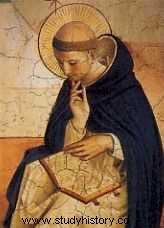Intro
At the beginning of the Middle Ages, religious faith was already deep and well anchored among European Christians. Despite a tendency to generate a certain fanaticism, it only rarely rose to the point of violence. Things changed, however, as the threat of Islam grew and spread...
Presentation of the historical context
The spread of Christianity
From AD 100, conversions to Christianity at the very heart of the Roman Empire alarmed imperial rulers. During the reign of Nero, the persecution was carried out at a dizzying pace. The theologian Origen, who had castrated himself so as not to succumb to the sin of the flesh, then wrote:“Faith in Jesus Christ sits down, feeds and spreads over mountains of martyrs”. The logic and morality of Greco-Latin thought could not understand the Christian. While the Romans indulged in paganism with delight, Emperor Constantine I was struck by a vision, and suddenly converted to Christianity. In fact, this Caesar cared less about his convictions than about a diplomatic opportunity.
Good versus Evil
In this very particular broth of culture that was the Middle Ages, stuffed with demonic fantasies and angelic visions, two actors play a leading role:God and Satan. Two parent antitheses of all excess between fervor and exaltation. Apart from Heaven or Hell, there is no alternative to mankind in this dark period. Saving his soul was the goal. Yet at the beginning of the barbarian invasions, God was feared, his anger was feared, but finally leaving the Merovingian period, the God exercising punishments gradually became a benefactor God incarnating Good, and Satan became the personalization of Evil.
The Wisdom of God
The image of God as an old man holding the globe spread in Western art during the 14th century.
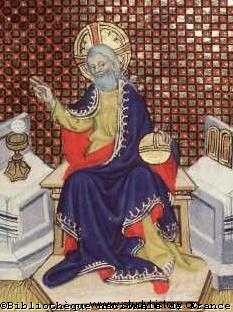
Hours for the use of Troyes (Troyes, B.m., ms. 3713, f. 093, 3713)
Various examples of religious fervor
The crusade against the Albigensians
Religious fervor was the great symptom of the Middle Ages, with the fall of the Roman Empire, Christianity appeared as a young and vigorous religion. A process of expansion subjected to evolutions from the dogmatic and spiritual point of view, gave it a beautiful dynamism. However, heresies and schisms flourished and multiplied. One of the most dangerous schisms was undoubtedly Arianism which denied the divinity of Christ. One of these heresies was that of the Bogomils of Bulgaria, which spread as far as the West. It was then a serious religious crisis in France which saw the Catholic Church clash with the Cathars and the Albigensians. The crusade undertaken by the papacy against the Cathar heresy was commanded by the ambitious Simon de Montfort. The papist armies ravaged Aquitaine, causing thousands of victims and destroying the most refined culture of the time:the Occitan civilization born of the myth of chivalry, chivalrous honor and courtly love, honored by the troubadours.
The pilgrimage to Santiago de Compostela
Tradition says that after being beheaded in Judea, the remains of Saint James the Greater, apostle of Christ, were brought in the greatest secrecy to the coast of Galilee. From there, it is assumed that they were embarked for Galicia end of the Iberian Peninsula. A local primitive cult maintained and perpetuated the memory of this event, keeping the burial secret until its discovery in the 9th century. The news then spreads in the Christian world of Europe in a vertiginous way, inflaming the spirits, exasperating the faith of all. A craze for this new apostolic cult will drain crowds of pilgrims in search of “the extraordinary”. Men set off, on foot along unsafe paths and paths, crossing impassable rivers and dense forests in defiance of all dangers. Pilgrims from Europe find themselves in France and notably cross the Col de Ronceveaux (the Song of Roland). The momentum of the Spanish Reconquista will give momentum to the pilgrimage.
James the Greater
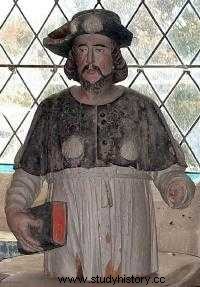
The Crusades
Blessed by the pope and led by the monarchs of the Christian kingdoms, this adventure was to represent all that the medieval spirit had in it. Eight crusades in total, involving all states (clergy, nobility, bourgeoisie and university), all castes combined. Blacksmiths, tanners and craftsmen equipped the Crusaders, shipyard workers provided the ships to cross the Mediterranean. The women made clothes, blankets, and embroidered with fervor the banners, signs and pennants which were to display the battlefields, many women of the Court followed the queen who sometimes accompanied her royal spouse. And the hierarchy of the clergy prayed from the highest cathedrals to modest chapels. The multiple camps in front of the besieged cities were prey to a particularly atrocious devotion. Thus, after the sacking of Palestine, Raoul de Caen, chronicler of the First Crusade wrote:“At Maarat, our people cooked the adult pagans in pots and skewered the children to eat them roasted. Some Muslim priests who knew where the Holy Cross of Christ was hidden were tortured, Jews were locked up in their synagogue and burned alive there. These outsized enterprises were mainly carried out by the Franks who lost more men during the Crusades than all the other Christian countries put together.
The Hierarchy of the Clergy
The clergy can be distinguished between:
- regular clergy :who follows the rule of a religious order.
- monastic order (Benedictans, Cistercians)
- mendicant order (Franciscans, Dominicans)
- secular clergy :who lives in the "century", i.e. in society.
We can also distinguish:
- High clergy, prelates :
- Pope
- Cardinals
- Bishops
- Archbishops
- Abbots
- Priors
- The lower clergy :
- Priests
- Lay Brothers
- Cure
Appendix:see the complete list of popes
Justice
Justice in the Middle Ages
The medieval era saw the coexistence of two concepts in matters of justice:
-
The first claiming Roman law, it is that of kings and the Church, which, after the fall of the Empire and the Christianization of the barbarians embodied the ancient prestige of Rome. Roman Law consisted of the application of justice by virtue of written laws and decrees:The law of the Twelve Tables of the republican era first, then the plebiscite laws or codes, at the time of the Empire. The Romans had adopted the Athenian way of dispensing justice.
-
The second is that of the people and the lords on their fief who wanted to establish their justice without giving an account, this mode of justice derives from the principles of Germanic law In essence, Germanic justice was very simplistic:the lord reserved the right to to inflict punishment on his subjects, applying vague concepts from ancient traditions. However, no law was written. The exercise of Germanic law by feudal lords was divided into three levels:
- High justice, which gave power of life or death and the granting of the use of torture as well as the seizure of property.
- The average justice was limited to punishing offenses that did not involve the death penalty but could lead to heavy sentences.
- Lower justice was restricted to the punishment of servants depending on the lord.
Scene of torture of a homosexual in the Middle Ages
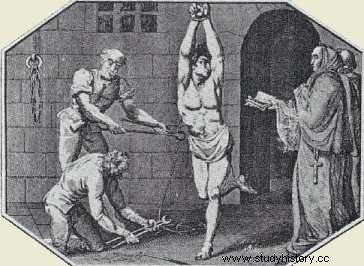
Justice and punishment
The concepts of Roman law and Germanic law collided over the centuries, many physical punishments reappeared in Europe. The main novelty introduced in Europe was the ordeal , it is a system aimed at demonstrating the guilt or innocence of the accused. This barbaric practice consisted in subjecting the accused to a difficult test which he had to overcome to prove his innocence. Among the most common:the basin of boiling oil in which the accused had to plunge a hand and come out unscathed or that of heated embers of coal that he had to seize without burning himself... Obviously in the majority of cases, the accusation was followed by capital execution. The Church did nothing to eradicate these brutal practices, on the contrary, she developed them with dexterity. A variant of the ordeal was that of the “judgment of God”:the accuser confronted the accused in mortal combat. Women and nobles could choose a champion to represent them. Another practice was that of quartering. The prisoner, after being hanged, beheaded, stoned, or riddled with arrows, was torn to pieces:each of the "pieces" was exposed publicly.
The Court of Inquisition
The Inquisition was responsible from the 13th century to repress heresy in certain Catholic states. The first known inquisitors, two monks of the order of Cîteaux during the Cathar heresy. It was in 1231 that Pope Gregory IX created the Tribunal of Inquisition, placed under the control of the Dominican order. First presented as a temporary judicial body, the Inquisition was transformed into a regular and permanent establishment by the Councils of the Lateran (1215) and of Toulouse (1229). Anyone could be prosecuted on simple denunciation, the main thing for the judges was to obtain the confession of the accused, which, from 1252, led them to use torture. By its brutal action, it was also used to fight other forms of heresy, to repress witchcraft, to persecute non-Christians or deemed such. In the 15th century, the progress of royal centralization gradually caused the courts of the Inquisition in France to fall into disuse.
Witchcraft and Satanism
In secret, bewitchment and exorcism were practiced. People believed in the power of talismans, amulets, or potions. Civil and religious justice was not long in waging a ferocious fight against these practices. Satanism refers to a master, Satan; it is a religion that openly opposes Christianity. But at that time, no distinction was made between witchcraft and Satanism. Even herbalism could be considered heresy.
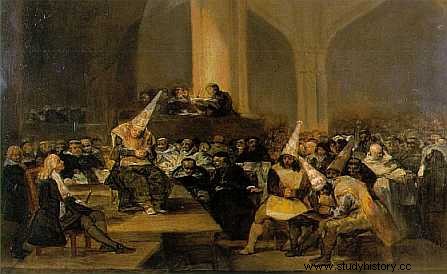
Inquisition Scene, by Francisco GOYA 1816 (Royal Academy of San Fernando, Madrid)
Orders
Knightly Orders
- The Hospitallers
- The order of the Hospitallers was founded in 1113 in Palestine to care for and protect the pilgrims who went there. Governed by a Grand Master, the Hospitallers took vows of chastity, poverty and obedience. After the loss of the Holy Land with the capture of Saint Jean d'Acre in 1291, they settled in Cyprus and conquered the island of Rhodes from the Byzantines in 1309. Charles Quint ceded the island of Malta to them; they then take the name of Knights of Malta. They continue to shine against the Turks and shine during the battle of Lepanto in 1571. The order remained in Malta until the capture of the island by Bonaparte in 1798. The order sits today in Rome and only has an honorary role.
- The Templars
- The Order of Knights of the Temple Militia was founded in 1119, for the defense of pilgrims in the Holy Land. It grew rich, owned estates and fortresses, served as a bank for pilgrims and, later, for kings. After the loss of the Holy Land, the order retreats to its European possessions. Faced with numerous hostilities, in particular because it came only under the Pope, the order was persecuted from 1307 by Guillaume de Nogaret and Philippe IV le Bel:arrested and subjected to questioning, the Templars confessed to crimes little probable. Pope Clement V convenes a council under pressure from the King of France. In 1312, Clement V pronounced the dissolution of the order of the Templars. The grand master of the order, Jacques de Molay, was executed in 1314, and the property of the Templars was transferred to the Hospitallers.
- The Teutonic Knights
- This hospitable and military order was founded around 1128 by the Crusaders in Jerusalem, but exercised its influence above all in Germany. The order soon benefits from considerable privileges and donations. Clashes with the Hospitallers prompted them to seek an establishment in Eastern Europe. Their advance in the East is limited by the Russians (defeat in front of Alexandre Nevski in 1242). In the 14th century, the grand master of the Teutonics appeared as one of the most powerful and richest sovereigns in Europe. The 15th century, however, saw their decline with the defeat of Tannenberg in 1410 against the Poles and Lithuanians. Napoleon abolished the order in 1809, which reformed in Austria in 1840.
The Treasure of the Templars
Much has been written about this famous treasure, many have searched for it in vain. Yet the order was infinitely rich, when the henchmen of Philippe le Bel invested the Temple of Paris, they found nothing. A procession of carts covered with straw, had left the capital the day before, it was said. It is said that the treasure was taken to the North of France to go to England. Other sources affirm that it was hidden in the mountains of Auvergne. Mystery...
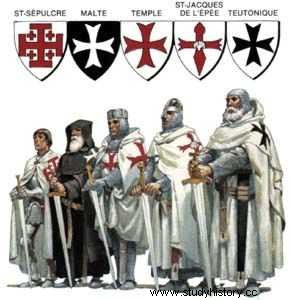
Distributed on www.mythes-et-legendes.net
Religious orders
Monastic life took shape, in its essential structures, between the 3rd and 12th centuries. According to Christian tradition, the monachus (monk) leads a retired existence, more or less solitary, this is true for the hermit and, to a lesser degree, of the cenobite (one who lives with other monks).
- The monastic orders (Benedictines, Cistercians)
- The Benedictine order, founded in the 6th century by Saint Benedict of Nursia, is the oldest monastic order in the West. From the 11th century, the order diversified:Cluniacs, Camaldolese, Carthusians... In 1098, with the creation of Cîteaux by Robert de Molesme, the order of the Cistercians was born, whose most famous theologian was Saint Bernard, Abbot of Clairvaux. But the breaches of the primitive purity of the rule are increasing, the prestige of the Cistercians is decreasing in favor of the mendicant orders.
- Mendicant Orders (Franciscans, Dominicans)
- Saint Dominic goes to preach in the Languedoc country plagued by the Cathar heresy. He becomes aware of the ignorance of the population and the clergy. He founded in Toulouse in 1215, the order of the Dominicans, a community of priests destined to lead a holy life, to itinerant preaching and teaching. It is an innovation to conceive of a religious life in contact with crowds and not in an isolated monastery. Saint Francis of Assisi, meanwhile, founder of the Franciscans (1210) had a personal encounter with Christ which led him to strip himself of all his past and marry Lady Poverty. The interior life of St. Francis is marked by the realization of his own sin and of the redeeming mercy of God. The Franciscans wear a brown robe with a cord for a belt (which earned them the name of Cordeliers), the habit of the poor of their time.
St Dominica
